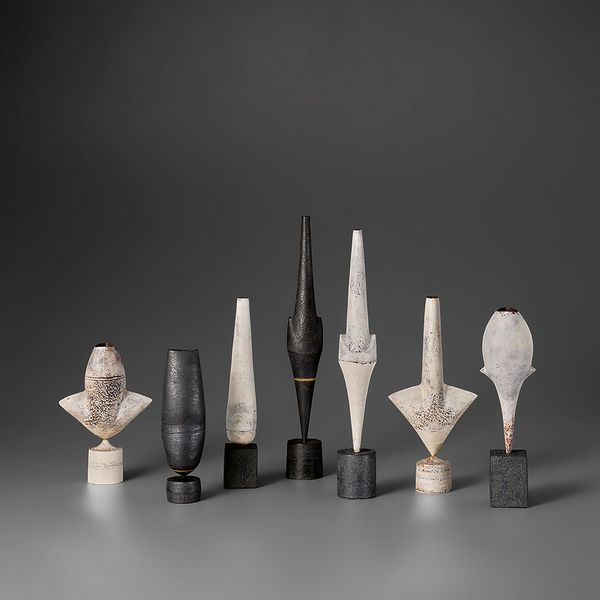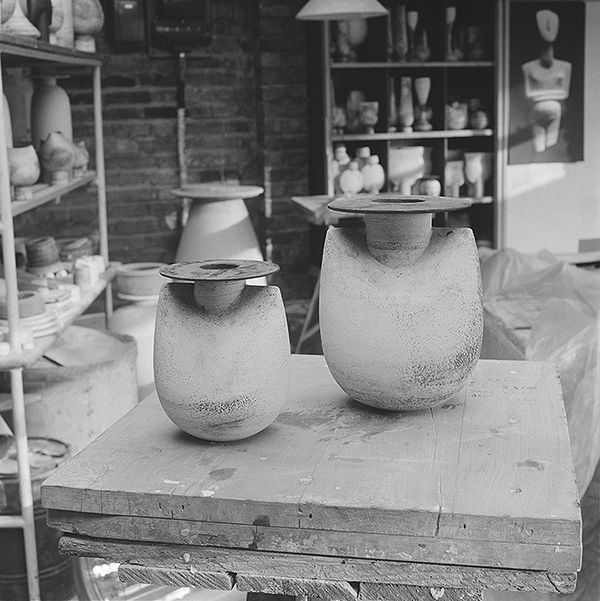Lot 393 Hans Coper White ‘Cycladic Arrow’ form, Lot 392 Hans Coper Rare black ‘Cycladic’ form, Lot 394 Hans Coper White ‘Cycladic’ pot on block base, Lot 305 Hans Coper Black ‘Cycladic Arrow’ form, Lot 304 Hans Coper White ‘Cycladic Arrow’ form, Lot 390 Hans Coper White ‘Cycladic Arrow’ form, and Lot 391 Hans Coper White ‘Cycladic Bud’ pot.
Here, David Whiting looks at how Hans Coper’s study of ancient Cycladic marbles helped to inspire and inform his Modernist vision. A remarkable selection of these feature in Phillips' much-anticipated 1 November 2023 ceramics auction in London — Lucie Rie and Hans Coper, Exceptional Ceramics: Selections from the Estate of Jane Coper and the former Collection of Cyril Frankel. View catalog.
This exceptional grouping of Hans Coper’s so-called ‘Cycladic’ pieces, made between circa 1965 and 1977, shows the development and variation of a form resulting largely from his absorption of Cycladic art, notably its marble figures, probably instilled when he was making his first visits to the British Museum in the post-war years. There he was deeply impressed by the collections of Neolithic, Ancient Egyptian, and Mycenaean art too, all of which had a bearing on his sculptural path. The London dealer William Ohly had introduced him to sub-Saharan African art and other tribal cultures, and he was discovering contemporary sculpture, excited by the figurative summaries of Brâncuși, Arp, and Giacometti, their ability to get to the core of the human frame, avoiding literalness.
The ‘Cycladic’ pieces grew out of both earlier and contemporaneous shapes of Coper’s that grappled with these issues. They can’t be understood in isolation. Anthropomorphism (pottery in any case is anthropoid by its very nature) was a general characteristic of his art. The different and periodic sequences of Coper’s ‘Cycladic’ work related closely to other pots of his which were more open, of fuller volume, more obviously ‘vessels.’ The earliest more recognizably ‘Cycladic’ shapes that came in the early 1960s developed ideas also explored in his ‘hourglass’ pieces, the ‘thistle pots,’ the large flattened ‘disc’ forms, the bottles, and so on. All these objects, like the standing figure, had that quiet, often frontal, sentinel presence, the result of Coper’s musing ability, refined as he got older, to summarize and distil. He was creatively the least peripatetic of makers.
©Jane Coper / Estate of the Artist.
It is difficult not to see the correlation between his ‘Cycladic’ shapes, particularly those that thicken and broaden out, and a reference piece he kept close to him in the studio. It was a very simple 17cm high spherical pot made in 1961, the narrow stem widening into a curvaceous body, but from a separately made square plinth, a composite element Coper was now occasionally using, and which would form a basis (in every sense) of his ‘Cycladic’ variations. Jane Coper once photographed this object next to another of Coper’s touchstones which we often refer to, a small and modest predynastic Egyptian egg-shaped pot that said everything to Coper about clay form at its most condensed, with its ‘minute quantum of energy.’ It was one of the seeds from which, along with Cycladic and other ancient Mediterranean sculpture and ceramics, much of his own work grew. If Coper was very much a lateral artist, working on different ceramic variations in tandem, his investigations came from the same basic roots and precepts.
The small and modest predynastic Egyptian egg-shaped pot that said everything to Coper about clay form at its most condensed, with its ‘minute quantum of energy.’ ©Jane Coper / Estate of the Artist.
The rare black ‘Cycladic’ form here, (Lot 392 Hans Coper Rare black ‘Cycladic’ form) with its elongated oval cylinder, is the earliest of the group, from circa 1965 and similar in shape to one of Coper’s first Cycladic explorations, of 1963 (illustrated in Tony Birks’s biography), a long and narrow cylinder resting, possibly for the first time, on a separately thrown cylindrical base. His innovation of fixing the two components together with a concealed steel knitting needle made the main body of the rising forms that followed seem weightless, with waists narrowing down to an almost invisible point of contact between the two sections. This created an extraordinary sense of upward energy and lift, sculpture that was floating, almost weightless. The technique, typical of his virtuosity, allowed Coper to evolve different formal objectives using the same basic premise, instilling some of the essence he found in those abstracted heads and figurines from the Cyclades.
The unusual white cylinder on a square black base, made circa 1977, (Lot 394 Hans Coper White ‘Cycladic’ pot on block base) is similar in spirit to that early 1963 example, but here much narrower and tapering sheer towards the top, an altogether very uncommon form. It is ostensibly the most succinct of the examples featured here, but as so often with his ‘Cycladic’ variants, you get the subtleties of a crease or band, a swelling or dimple, denoting something obliquely bodily or facial, but also a way of gently punctuating and softening the surface, accentuated by the texture of the clay, and the covering glazes, slips and engobes. As much as his pots could express that kind of paring down he so admired in his favourite Modernist sculptors, they were equally about expansion, not just in the ‘Cycladic’ pieces, but in the thistle pots and spades that broaden out, yet still with that essential frontality of the earliest Mediterranean figures, the same bodily delineations. The two fine arrows here from 1972, (Lot 390 Hans Coper White ‘Cycladic Arrow’ form and Lot 393 Hans Coper White ‘Cycladic Arrow’ form) one of them more solid and bulbous, the other slimmer and sharper, seem to directly reference the summarized angularities of Cycladic marbles, but here the pronounced shoulders of Cycladic figurines become wing-like in Coper’s pots. These shoulders are greatly narrowed in the two slimmed-down arrows from 1976, (Lot 304 Hans Coper White ‘Cycladic Arrow’ form and Lot 305 Hans Coper Black ‘Cycladic Arrow’ form) and reduced to nodes in the equally striking ‘Cycladic bud pot’ made in the same period, (Lot 391 Hans Coper White ‘Cycladic Bud’ pot) a piece reminiscent of Brâncuși’s strange and otherworldly abstracted heads, but also one of Coper’s most organic concepts. It is equally suggestive of a plant, a structure of upward growth towards the light, the small sprigs of clay perhaps the last vestiges of bodily joints and protrusions as Coper continuously searches for economy.
It is interesting to see how Coper worked with color contrasts too, for example placing the main body of his white arrows on black bases and vice versa. It was all part of his study of proportion, and the sectional relationships of his composites. His ‘bud’ forms might be similarly interchanged, while other pieces had almost wholly monochrome exteriors, two instances of which we see here. The white ‘Arrow’ in this group is useful to compare to his all-black versions, some on a square base, an equally elegant example of which can be seen in the Victoria and Albert Museum. These Cycladic variants really form a microcosm of Coper’s work as a whole, the way in which his art evolved and often returned to the same themes, adding or subtracting details, always in pursuit of a kind of quintessence, gauging surface, volume and contour. In that overriding preoccupation with the vertical incision of space, he could make something almost votive in these totems. They are both intimate and tactile, but equally found their grandest ritual expression in his Coventry Cathedral altar candlesticks, closely related in concept and made just as the ‘Cycladic’ forms we see here were first being realized.
Discover More from Design, London >
Recommended Reading
Lucie Rie: Vienna to London >
The Personal Pots: The Jane Coper and Cyril Frankel Collections >


